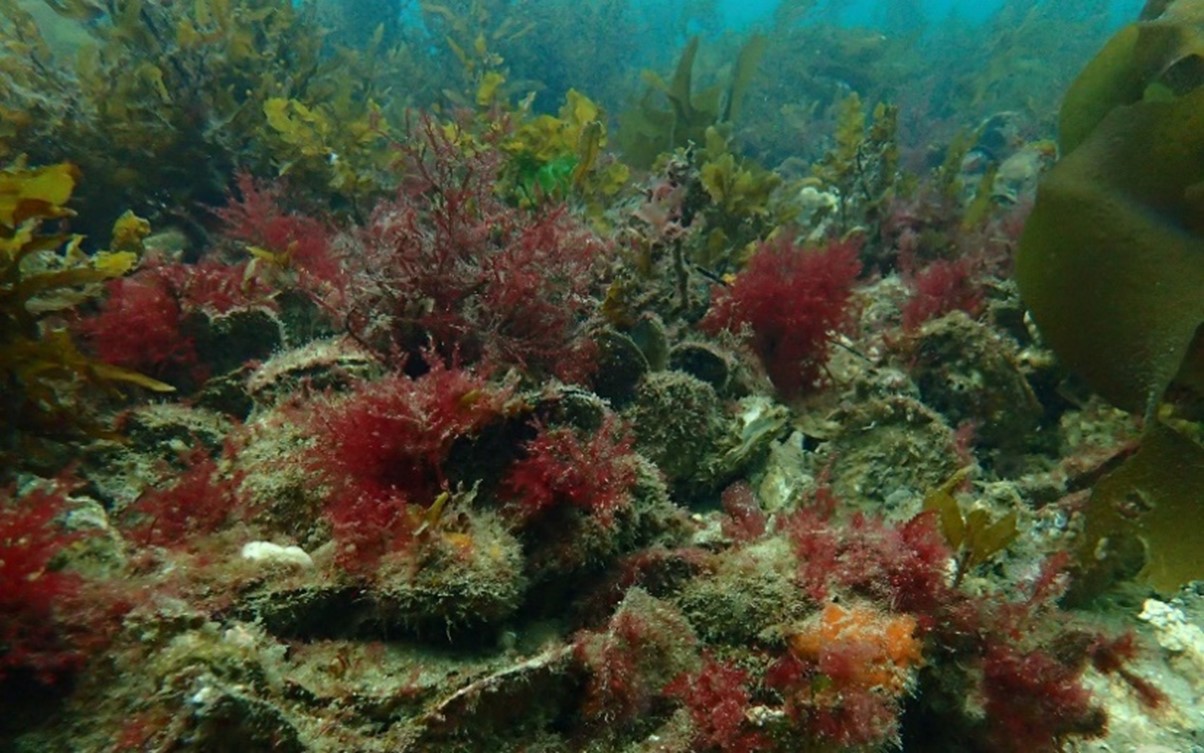
You may like to pair oysters with a nice glass of champagne or with lemon and tabasco, but have you ever thought about their mysterious lives beneath the sea? There is a reason South Australia is famous for their oysters and not just the ones that end up on your plate at a fine dining restaurant. Oysters are in fact ecological superheroes and form a vital part of our Great Southern Reef here in southern Australia.

The last surviving native mud oyster reef in Georges Bay, Tasmania. Credit: Chris Gillies.
Like the rainforests are the lungs of the planet, oysters are the kidneys of our oceans. A single oyster can filter up to 100 litres of water a day. Transfer that to the millions of oysters on a reef and the filtering capacity is incredible! With clearer waters allowing more sunlight as well as a nutrient rich sea floor, thanks to the deposition of oyster faeces, neighbouring seagrass meadows flourish. This in turn, encourages more species to establish in these habitats and ultimately, underpins the coastal food web. The deposition of oyster faeces also promotes the growth of specific bacteria which convert excess nitrogen into nitrogen gas. This helps to prevent algal blooms which can be detrimental to the growth of other species.
What’s more, aggregations of oysters provide a haven for a diversity of small fish and invertebrates. Just a 25cm squared patch of oysters can host more than 1000 individual invertebrates! Not only do these habitats bolster an array of marine life, but oyster shells also cast shade, trap moisture, and provide shelter for semi-aquatic animals like snails and crabs. These animals live on intertidal rocky shores and are particularly susceptible to extreme temperature changes during low tide. The aggregated shells of oysters help counteract these climatic extremes with temperatures up to 10°C cooler than neighbouring habitats during hot days.
The physical structure of oysters also dissipates wave energy which helps to protect saltmarshes and corresponding coastlines from erosion. If that’s not enough, oysters are essentially carbon sinks as well! Their shells made from calcium carbonate are buried and compacted to rock, which helps to prevent carbon dioxide from cycling back into the atmosphere.
If you have ever heard the saying, “the world is your oyster”, well, that is certainly the truth for these temperate marine ecosystems. Unfortunately, though, over 90% of Australia’s oyster reefs have vanished since European settlement. Once forming extensive reefs along more than 1500km of South Australia’s own coastline, the native mud oyster, Ostrea angasi, remains as only one healthy reef in Tasmania.

A healthy oyster reef in Tasmania as South Australian reefs would have been in 1836 (left) compared to the remnant seafloor today (right). Credit: Chris Gilles.
Archaeological research shows that for over 5000 years, the Indigenous people of Australia sustainably harvested oysters and replenished the populations by building reefs from stones and shells. But after colonisation, Europeans harvested oysters for food and burnt their shells to create lime for cement and fertilisers. Although these extensive fishery efforts ended over a century ago, the once abundant oyster populations were never able to recover. Baby oysters rely on the shells of their ancestors as a substrate to settle on and grow, but subsequent dredging of the sea floor and additional sedimentation removed any chances for them to regrow.
However, all was not lost for our ecological superhero oysters. Recent reef restoration projects show a promising future for these precious marine ecosystems. There are currently 46 shellfish reef restorations underway in Australia. One of our very own projects in South Australia, the 20-hectare Windara Reef, is the largest of its kind in the Southern Hemisphere. These man-made reefs, which use limestone or old shells to provide substrate for oysters, have been settled by baby oysters within months of construction. The enormous success so far is due to public support, with many coastal communities leading these restoration programs.

Discarded oyster shells from restaurants are being recycled into man-made reef structures as part of a community-led oyster restoration program. Credit: OzFish.
Once at the brink of extinction, oysters are now at the forefront of conservation, and rightfully so. Without these ecological superheroes, we would lose the precious marine life that sustains biodiversity and the livelihoods of many people.
Written by Chelsea Foubister
References
Baczkowski, H 2021, ‘Waste oyster shells getting a second life after being recycled to create artificial reefs’, ABC News, 16 October, viewed 5 October 2022, <https://www.abc.net.au/news/2021-10-16/oyster-shell-waste-artificial-reef/100538272>.
McAfee, D & Connell, S 2017, ‘Huge restored reef aims to bring South Australia’s oysters back from the brink’, The Conversation, 28 June, viewed 4 September 2022, <https://theconversation.com/huge-restored-reef-aims-to-bring-south-australias-oysters-back-from-the-brink-77405>.
McAfee, D 2018, ‘The surprising benefits of oysters (and no, it’s not what you’re thinking)’, The Conversation, 19 February, viewed 4 September 2022, <https://theconversation.com/the-surprising-benefits-of-oysters-and-no-its-not-what-youre-thinking-90697>.
McAfee, D, Gillies, C, Crawford, C, McLeod, I & Connell, S 2022, ‘Once the fish factories and ‘kidneys’ of colder seas, Australia’s decimated shellfish reefs are coming back’, The Conversation, 9 August, viewed 4 September 2022, <https://theconversation.com/once-the-fish-factories-and-kidneys-of-colder-seas-australias-decimated-shellfish-reefs-are-coming-back-184063>.
Preston, J 2019, ‘The world’s most degraded marine ecosystem could be about to make a comeback’, The Conversation, 3 May, viewed 4 September 2022, <https://theconversation.com/the-worlds-most-degraded-marine-ecosystem-could-be-about-to-make-a-comeback-110233>.